Even if it borrows heavily from other popular games across both genres, Valorant’s hero-meets-tactical shooter gameplay is a pretty unique experience. There isn’t too much else out there offering that same coming together of the two, which means it’s likely to attract a bunch of newcomers to the FPS genre in addition to Counter-Strike veterans looking for something novel. And that’s exactly who this Valorant tips & tricks guide for beginners is targeted at. So, if you’ve just started playing as a newbie, here’s hoping this will help.
Tips & Tricks for Valorant Beginners
If you’ve played Counter-Strike even at all then you’ll be familiar with Valorant’s bomb plant/defuse gameplay loop. For everyone else, here’s a quick reminder that in Valorant, each match is divided into two halves: attackers, and defenders. You are essentially playing a best of 24, with the first team to hit 13 rounds declared the winner.
In addition to some basic dos and don’ts, we’re going to break this guide down into two sections that cover both attacker and defender tips.
The Basics – Valorant Tips & Tricks
Tweaking Your Set up
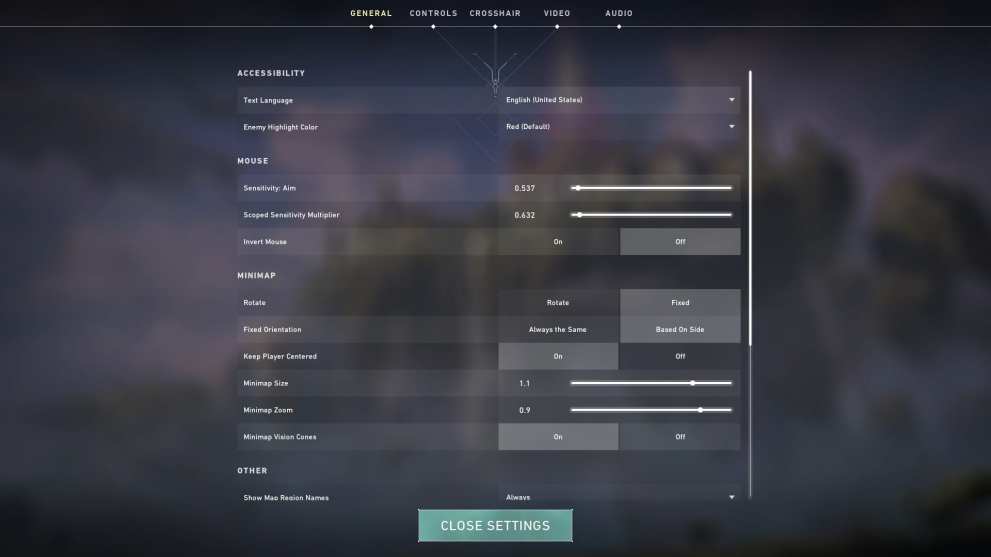
Before we dive into actually playing Valorant, let’s take a second to consider how we can best optimize our setup from the main menu.
Valorant offers a fantastic level of customization from its settings menu, from audio and graphical tweaks to the ability to optimize the HUD. How you set the game up will ultimately come down to preference, but here are a few key areas to be aware of and consider:
Sensitivity – Do yourself a favor and spend 10 minutes in the shooting range in an attempt to discover a sensitivity you are comfortable with. Professional players typically with anything from 0.4 – 1.5 with 400 to 800 DPI. DPI is the dots per inch that your cursor moves across the screen. Use this calculator to find your DPI if your mouse does tell you as standard.
Also, remember that Windows has Enhanced Pointer Precision on by default and you may find turning this off helps since it reduces mouse acceleration (search Mouse Settings from your Windows taskbar, advanced, unlock Enhanced Pointer Precision).
Crosshair – Find a crosshair that offers you good visibility against background colors and isn’t too distracting. We prefer green, default size, no outline, and movement error switched off. Keep in mind that some colors fade into the background more easily than others. For example, white, which all but disappear when overlaid on any bright surface in the game.
Mini-Map – By default, Valorant’s mini-map will spin around and follow the player’s direction when they are moving. This can be quite disorientating, especially when you don’t know Valorant’s maps. Consider switching it off until you learn each map.
Graphical optimization – In tactical shooters such as Valorant, performance is everything. If you’re struggling with framerates, one can easily display their FPS by accessing the game’s video options. From here, you can get an idea of how your PC is coping with running the game. If you can’t hold a constant 60 FPS, lower your graphical settings. Ideally, you want to have at least 99 FPS.
Walking and Movement
For newcomers to the tactical shooting genre and Valorant itself, remember that this is not a twitch shooter like Doom, Halo, and even Overwatch. That is to say, you are not expected to run around the map attacking enemies wildly. In fact, most of the game you are going to be walking and keeping very silent.
Any time that you run should be a calculated decision. Why? Because surprise is your biggest advantage in a game like Valorant and any time the enemy can hear you –running, reloading, picking up weapons, using utility, etc– you are giving away that advantage and opening yourself up for being taken out.
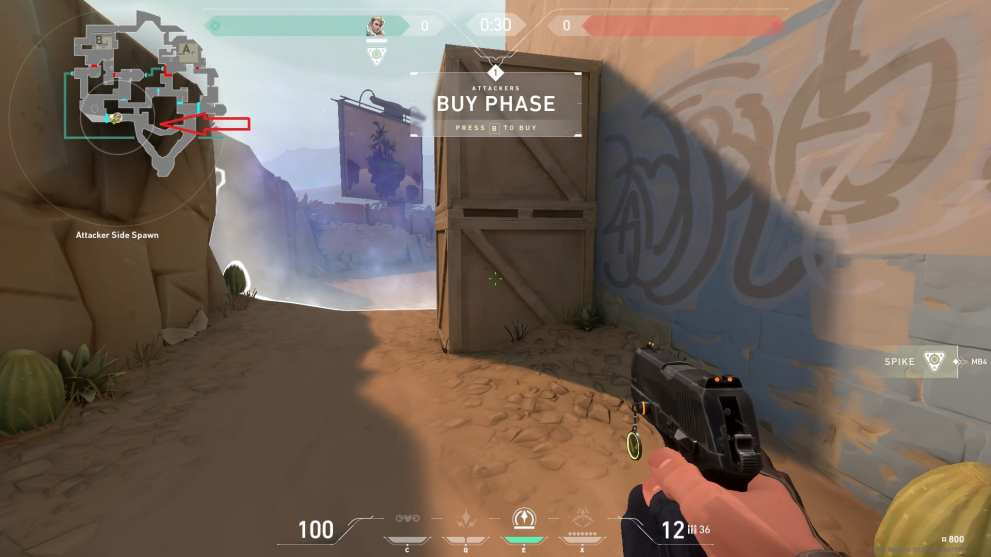
One easy way to keep yourself in check is quickly looking at the mini-map as you run and notice the white ring around your avatar. This highlights how far the sound of your footsteps is traveling.
Aiming, Shooting, and Controlling Recoil
Valorant’s recoil system isn’t as punishing as Counter-Strike, but it still requires players to treat shooting in a somewhat realistic fashion. As in, you can’t just hold down the trigger and expect bullets to track to the target like a laser beam. Instead, you’ll need to control your shooting with short burts.
As a general rule, 3-round bursts are what you should be going for when standing or crouching as you shoot at a target from a medium or long distance.
Spraying is something you must learn to limit to all but the closest ranges, and it is advisable to crouch when doing so to further contain recoil.
Another entry-level tip we would suggest is to learn to drag your crosshair down as you spray, or even during longer bursts. You may have noticed that bullets start tracking upward when you hold the trigger down, and this is a practice you’ll see Counter-Strike players use to compensate. It works in Valorant, too.
Playing the Objective
As we’ve mentioned above, Valorant is a game about planting or defusing the bomb (spike). So, play that objective! Winning the game is achieved by winning rounds, which you won’t do by frag-hunting and ignoring the spike. Make sure that if you have the spike you’re being responsible and sticking with your team, and planting when you all enter a bomb site.
Further, make sure you’re keeping the status of the spike on your mind at all times, regardless of being an attacker or defender. By that, we mean keeping an eye on the timer, the location of your teammates, and listening for movement to gain situational awareness to assist you in determining the status of the objective.
Let’s say, for example, you’re the last player on the defending team and you know the opposition is running to plant the spike. Do they have enough time to actually get it down? If it’s unlikely then make sure you run and hide to win the round rather than frag-hunting.
Economy & Buying the Correct Weapons
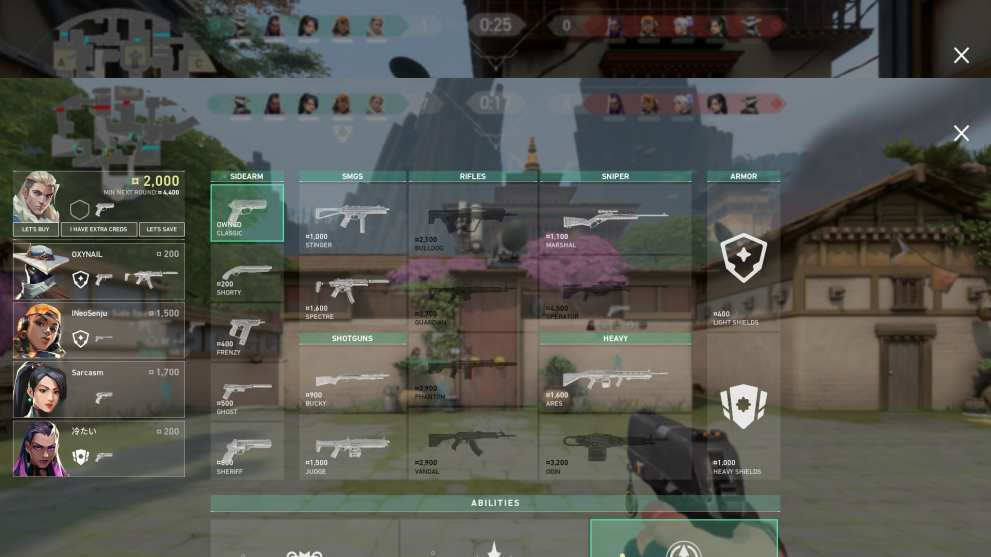
In another similar mechanic borrowed from Counter-Strike, Valorant has an in-match economy that determines what you can buy at the start of each round. The more you win and the more players you kill, the more you will have to spend. But there is a fairly predictable ebb and flow to the economy that you’ll want to try and learn.
If your team loses the pistol round, for example, you will likely want to “save” or “eco” the next round so that you have plenty of money for round 3.
Our top entry-level tip for the game’s economy is to appreciate that Valorant has a system that allows players to request guns they cannot afford. Simply right-click on the weapon, and, if you’re lucky, a teammate might purchase the gun for you. It’s often a good idea to purchase weapons for others so that everyone is well-equipped for the round, rather than hoarding money for yourself.
Using Hero “Utility” (Abilities)
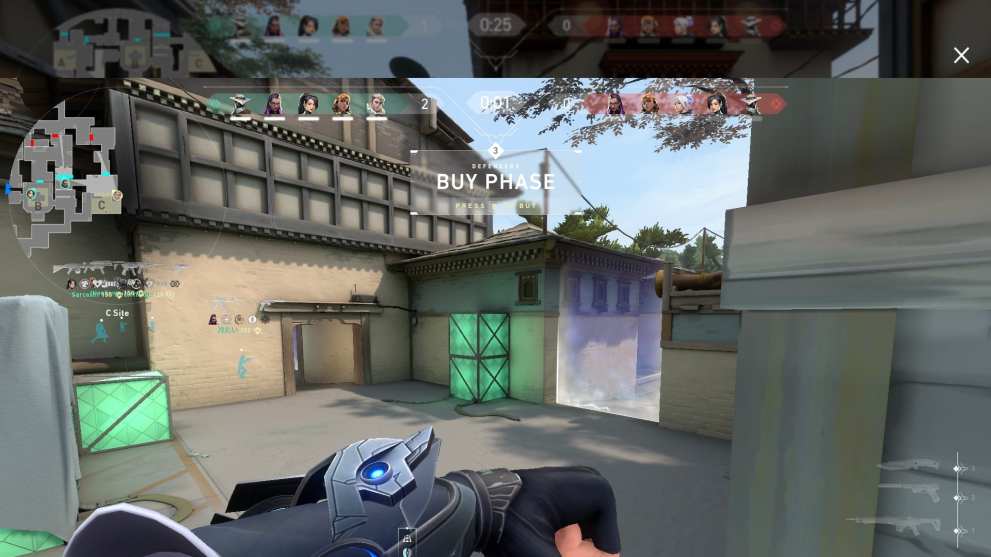
Valorant’s hero play is what sets it apart from tactical shooters like Counter-Strike. Understanding how to use your hero’s “utility” correctly is a big part of the game and something you’ll need to practice in order to improve.
That isn’t always easy for newcomers when playing a standard game, though, so we recommend hopping into its more casual Spike Rush mode to experiment.
Each hero posses abilities designed to help teams control a given map as both an attacker and defender, but some are better at one than the other. Learn to appreciate which is which and how their utility benefits the team in different situations.
One basic but important thing to keep in mind is that hero play in Valorant is a compliment to your gunplay, not a replacement. By that we mean, shooting your gun is first and foremost the most effective offense in most cases. Hero abilities are just there to help gain you an edge in using your weapon.
For example, Phoenix’s flash is designed to blind enemies before rushing them, while Sova’s surveillance darts illuminate targets so that you and your team can move in to shoot them.
Of course, there are exceptions to this rule such as Raze’s grenades and Viper’s Snake Bite, but you shouldn’t be looking to kill enemies specifically with your abilities as you might in other hero shooters. In Valorant, it’s more of a situational occurrence.
Communication
Valorant is a game that really demands coordination and communication with your teammates. Of course, this isn’t always possible or viable to the extent you’d like with other random players on the internet. But you should at least try.
Even if you’re doing the bare minimum –say, informing the team via team chat that there are no enemies in a certain bombsite after having pushed into the area– is a huge benefit to everyone. Hopefully, you’ll get some intel from your teammates in return that will also prove useful.
Attacking – Valorant Tips & Tricks
Picking and Rushing
When attacking a bomb site, your objective is obviously to get inside a site and plant the spike.
Of course, the defenders are very deliberately given an advantage; attacking a bomb site is harder than defending it since there’s always a choke point that the defenders will have their guns and hero utility trained on.
But attackers typically do have numbers on their side. As you move into a bombsite you’ll likely have four or five to the enemy’s two or three.
Leveraging this advantage is critical, and there are two ways to do so: picking, and rushing.
Picking is the practice of approaching a bombsite slowly and trying to weaken it by killing one or more enemies before entering the site.
Rushing is the practice of entering the bomb site with speed and overcoming defenders by sheer force.
Typically, attacks on bomb sites will employ both of these strategies. Unlike in Counter-Strike, we only really recommend a pure rush on pistol round in Valorant. That’s because the hero abilities that defenders posses can stop a rush dead in its tracks far more effectively than flashbangs, smokes, and grenades in Counter-Strike.
Instead, you’ll want to bait the defenders’ utility (their hero abilities) before running into a bombsite.
But rushing is still critical. The important thing is that when the attackers go in for a rush –once they have baited the utility–, that they are all coordinated and 100% committed. Do not start rushing and then stop because a teammate dies or some utility is thrown. Keep going. Get into the site. Use your numbers advantage.
Planting the Spike, Covering the Site
For beginners, another key thing to remember about attacking is the placement of the spike. Once you’re in the bombsite and you’ve decided it’s clear to plant, make sure you’re doing so in a strategic location. Then, once it’s down, you’ll also need to ensure both you and your surviving teammates have set yourselves in up effectively to defend it.
Here’s an example:
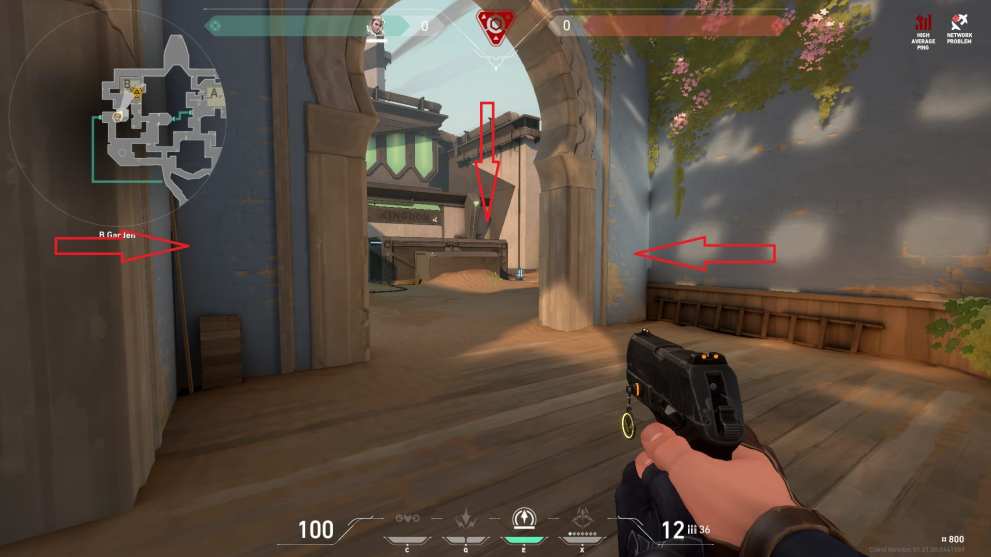
In this example, we’ve planted the spike in B site on the map Bind. The arrows indicate where we suspect the enemy is approaching from based on information from teammates and the general ebb and flow of the game.
Notice how the spike is planted in a location that forces the enemy to defuse in our line of fire whilst also allowing us to hide/retreat. In theory, it will be impossible for the enemy to defuse the spike without taking us out first.
You always want to try and achieve this sort of dynamic with your spike placement. As you can see, regardless of whether the enemy approaches from his spawn, the tunnel to the left, or the hookah lounge/window to the right, we will have a clean line of sight.
And if you’re wondering what the correct strategy would be to defend the spike in this situation, the answer would depend on how many enemies were remaining.
If it were just one we would hide until we heard the telltale defusal noise, then pop out and shoot. If it were multiple enemies we might peek and attempt to lure them into a gunfight before defusing, simply because otherwise they have the advantage of being able to defuse and set up cover unless we act fairly quickly.
Defending – Valorant Tips & Tricks
Peeking, Covering Angles
The defending team in Valorant wins the round when they prevent the spike from being planted within the time limit. That means you are essentially playing a waiting game and will generally be moving around the map less.
The fundamentals of defending are to have a team set up that covers all the angles of the bomb site and ensures that the attackers cannot enter or move around freely without being detected.
There are two important things to remember here both as an individual and a team. First, identifying effective locations to cover entry points to each site. Second, once the round has begun, to continually “peek” the angle and ensure you are observing the angle but not doing so in a way that makes you static target.
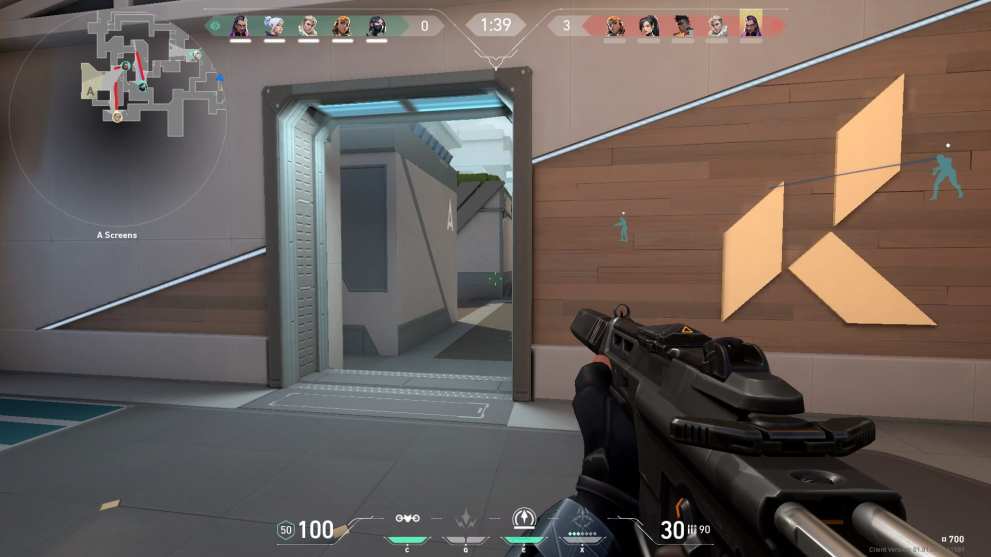
In the above example, we are playing the map Split and covering the A spike site. We have chosen Sova and have positioned ourselves to cover what is typically referred to as “A Long.”
Look at the mini-map. We have highlighted lines of sight in red. You can see that we have a teammate camping in a corner waiting for enemies to run around the corner. There is also a teammate watching “A Short” or “Heaven.” Importantly, no enemy can enter A without us knowing.
In this arrangement, the idea is that us as Sova can use a surveillance dart to illuminate targets for our teammates. Regardless of whether or not we see any targets, we will be peeking consistently throughout this round, moving left to right, watching for enemy movement.
If we spot targets, and if the enemy spots us, we will attempt to draw some fire towards ourselves and distract them from our camping teammate. Meanwhile, our second teammate watching A Short/Heaven will make sure we are not both flanked. They will also be concerned with listening for a push through mid.
This is just one brief example of how a defending team sets up their defense of a spike site. There are different arrangements for this site, too. Ultimately, everything comes down to coordination.
Pushing
You don’t always have to play completely passive when defending. Pushing is a tactic that basically means going on the offensive and advancing toward where the enemy is likely to come from.
However, it is typically only done when you are fairly certain the enemy isn’t going to be stacked just around the corner. That is to say, this isn’t an aggressive advance but a slow, measured movement forward to narrow down where the enemy is on the map.
The point of a push is to communicate the information back to your team and possibly take the enemy unawares. But it must be stressed the latter is a bonus.
If your team is being steamrolled, consider communicating a plan to push from one direction as the defending team. This could be a beneficial change in strategy from simply sitting tight and waiting for the enemy to come to you.
Remember to stealthy when you push and keep communicating with your team. If midway through your push your teammates suddenly appear to be coming under heavy fire, you will need to make a judgment call as to whether to run to their aid or continue moving silently in an attempt to catch the enemy unawares. As always, keep the round time firmly in your mind.
Rotating
Rotating from one spike site to another is as simple as it sounds. You will often need to swap from, say, spike site a to be if you notice that the enemy appears to be advancing on that site. Without your assistance, the enemy will more easily be able to take the spike site and gain the advantage.
The skill behind rotating comes from making the correct call as to when it should be performed.
You will need to rely on your team to call the position of the enemy. Of course, in public servers, this may not happen, and so you’ll want to pay close attention to how many players have died so far in the round, and where they died.
Pro tip: Get into the habit of checking your mini-map. When enemies are spotted by your teammates, and when they shoot their weapons, their avatar will briefly appear on the mini-map. This is your chance to gain valuable intel on their position.
Retaking the Site
As a defender, retaking a spike site after the spike has been planted is going to be your toughest assignment. Every situation will call for a slightly different tactic, and making the correct call is going to come down to a matter of experience.
Generally, the enemy is likely to have planted and hidden. They will be waiting for you to expose your position or attempt to defuse the spike before attempting to enter a gunfight. The only exception to that rule would be if you were heavily outnumbered.
So, given what we know about their likely course of action, you will need to use a combination of deception, hero utility, and raw aim to win the round.
Some things to keep in mind when entering the spike site:
- What can you hear? What can you see? Where is the spike located?
- Which angles are the enemy like to have cut off and where would they be hiding according to where the spike is?
- Which teammates are nearby and are you coordinating your movements? Always approach the site together if possible.
- What hero utility do you have available and how will it benefit you to deploy it?
- What deception can you use to bait the enemy from their positions?
That wraps up our beginner’s tips & tricks guide for Valorant. Remember to be patient and work together with your team. Also, be prepared to fail as trial and error before you can expect to find success. Only through experience will you get better.
For more useful Valorant guides, search Twinfinite via the homepage.
